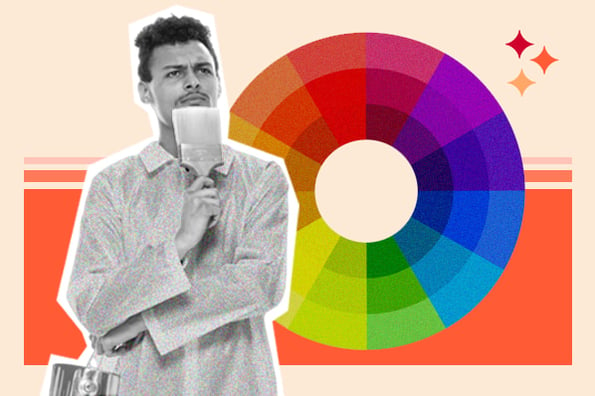The Importance of Color in Design
Color is an essential element in design as it plays a crucial role in grabbing attention and evoking emotions. Understanding color theory is essential for designers to create eye-catching compositions that effectively communicate their message. By utilizing the right combination of colors, designers can create visually appealing designs that captivate their audience. In this article, we will explore the key principles of color theory and how designers can use them to create compelling compositions.
1. The Color Wheel
The color wheel is a fundamental tool in understanding color relationships. It consists of twelve colors arranged in a circular format. The primary colors, red, blue, and yellow, form the basis of the color wheel. Secondary colors, such as purple, green, and orange, are created by mixing two primary colors. Tertiary colors are formed by mixing a primary color with a neighboring secondary color. The color wheel helps designers identify complementary, analogous, and triadic color schemes.
2. Complementary Colors
Complementary colors are opposites on the color wheel and create a high contrast effect when placed together. For example, red and green or blue and orange are complementary pairs. This color scheme is commonly used to create visual impact and can be useful when designers want to highlight specific elements or create a sense of excitement in their compositions.
3. Analogous Colors
Analogous colors are adjacent to each other on the color wheel and create a harmonious, soothing effect. For instance, yellow, yellow-orange, and orange form an analogous color scheme. Designers often use analogous colors to create a sense of unity and cohesion in their designs. This color scheme works well when designers want to establish a calm and balanced composition.
4. Triadic Colors
Triadic colors are evenly spaced around the color wheel and create a vibrant and dynamic look. A triadic color scheme can be achieved by selecting three colors that are equidistant from each other, such as red, blue, and yellow. Designers often employ triadic colors when they want to create a visually striking composition with a variety of colors.
5. Color Harmony
Color harmony is crucial in creating eye-catching compositions. By using color combinations that work well together, designers can establish a pleasing visual experience. Some commonly used color harmonies include monochromatic, analogous, complementary, and triadic color schemes. Experimenting with different color harmonies can help designers find the right balance and create compositions that resonate with their audience.
6. Color Psychology
Colors evoke different emotions and can influence how viewers perceive a design. Understanding color psychology is essential for designers to convey the desired message effectively. For example, warm colors like red and orange can evoke feelings of excitement and energy, while cool colors like blue and green can create a sense of calmness and serenity. By strategically using colors, designers can evoke specific emotions and create a more impactful composition.
7. Color Contrast
Color contrast is essential to create visual interest in a composition. Using contrasting colors can make certain elements stand out, improving readability and overall design effectiveness. Designers can achieve contrast by utilizing complementary or high contrast color combinations. By incorporating color contrast, designers can guide the viewer’s attention and create a more engaging visual experience.
8. Color in Typography
Color plays a vital role in typography as it can enhance readability and convey meaning. When choosing colors for typography, designers should consider the contrast between the text and background. High contrast ensures legibility, while low contrast can create a more subtle
Summary
Color theory is the science and art behind using color effectively in design. It involves understanding how colors interact with each other and how they can be combined to create harmonious or contrasting compositions. By understanding color theory, designers can make informed decisions about color choices, ensuring that their designs are visually engaging and communicate the desired message effectively.
In this blog post, we will cover various aspects of color theory, including the color wheel, color harmonies, and color psychology. We will explore different color schemes and how they can be used to evoke specific emotions or create a desired atmosphere. Additionally, we will discuss the importance of contrast, balance, and hierarchy in color compositions, as well as provide practical tips for choosing and combining colors effectively.
By the end of this blog post, you will have a solid understanding of color theory principles and be able to apply them confidently in your design projects. Whether you are a beginner designer or a seasoned professional, check this site out mastering color theory will undoubtedly elevate your design skills and help you create eye-catching compositions that leave a lasting impression.
FAQ:
Q: What is color theory?
A: Color theory is a field of study that explores how colors interact with each other, how they can be combined to create harmonious compositions, and how they affect human emotions and perceptions.
Q: Why is color theory important for designers?
A: Color theory is essential for designers as it helps them make informed decisions about color choices in their designs. Understanding color relationships and the psychology behind colors can greatly impact the effectiveness and aesthetics of a design.
Q: What is the color wheel?
A: The color wheel is a visual representation of colors arranged in a circular format. It consists of primary, secondary, and tertiary colors, along with their various shades and tints. The color wheel helps designers understand color relationships and make color combinations that work well together.
Q: What are complementary colors?
A: Complementary colors are pairs of colors that are located opposite each other on the color wheel. When used together, they create a high contrast and vibrant effect. Examples of complementary color pairs include red and green, blue and orange, and yellow and purple.
Q: What is color harmony?
A: Color harmony refers to the pleasing arrangement of colors in a design. It is achieved by selecting colors that work well together and create a sense of balance and unity. Common color harmonies include analogous colors, monochromatic colors, and triadic colors.
Q: How can color evoke emotions?
A: Colors have the power to evoke specific emotions and feelings. For example, warm colors like red and orange can create a sense of excitement or energy, while cool colors like blue and green can evoke calmness or tranquility. Designers can strategically use colors to influence the mood and emotional response of viewers.



